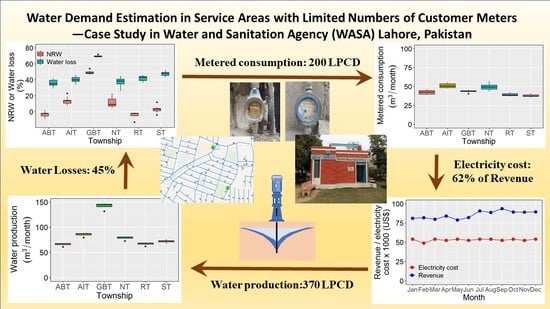Water Demand Estimation in Service Areas with Limited Numbers of Customer Meters—Case Study in Water and Sanitation Agency (WASA) Lahore, Pakistan
Abstract
:1. Introduction
2. Materials and Methods
2.1. Water Supply in Lahore
2.2. Study Area
2.3. Data Collection
2.3.1. Water Consumption
2.3.2. Water Production
2.3.3. Electricity Consumption
2.3.4. Static Groundwater Level
2.3.5. Population
2.3.6. Water and Sewer Tariff and Customers Bill
2.3.7. Customer Satisfaction Survey
2.4. Data Analysis
3. Results
3.1. Water Demand Estimation
3.1.1. Primary Water Category
3.1.2. Billed Water Consumption
3.1.3. Metered Water Consumption
3.1.4. Water Production
3.1.5. Non-Revenue Water (NRW) and Water Loss in Tajpura
3.1.6. Water Demand
3.2. Factors Influencing Water Demand
3.2.1. Static Groundwater Level
3.2.2. Electricity Consumption and Cost
3.2.3. Customer Bills
3.3. Customer Satisfaction Survey
4. Discussion
4.1. Estimation of Water Demand, Water Production, and Water Loss
4.2. Factors Influencing Water Demand
4.3. Customer Perception of Water Supply Service
5. Conclusions
Author Contributions
Funding
Institutional Review Board Statement
Informed Consent Statement
Data Availability Statement
Acknowledgments
Conflicts of Interest
Appendix A


References
- Amponsah, S.K.; Otoo, D.; Todoko, C.A.K. Time series analysis of water consumption in the Hohoe municipality of the Volta region, Ghana. Int. J. Appl. Math. Res. 2015, 4, 393–403. [Google Scholar] [CrossRef] [Green Version]
- Mekonnen, M.M.; Hoekstra, A.Y. Four billion people facing severe water scarcity. Sci. Adv. 2016, 2, e1500323. [Google Scholar] [CrossRef] [PubMed] [Green Version]
- Nauges, C.; Whittington, D. Estimation of Water Demand in Developing Countries: An Overview. World Bank Res. Obs. 2010, 25, 263–294. [Google Scholar] [CrossRef] [Green Version]
- Boretti, A.; Rosa, L. Reassessing the projections of the World Water Development Report. NPJ Clean Water 2019, 2, 15. [Google Scholar] [CrossRef]
- The United Nations. World Water Development Report. Leaving No One Behind; United Nations: New York, NY, USA, 2019; Available online: https://en.unesco.org/themes/water-security/wwap/wwdr/2019 (accessed on 15 June 2022).
- Srinivasan, V.; Lambin, E.F.; Gorelick, S.M.; Thompson, B.H.; Rozelle, S. The nature and causes of the global water crisis: Syndromes from a meta-analysis of coupled human-water studies. Water Resour. Res. 2012, 48, W10516. [Google Scholar] [CrossRef]
- Kummu, M.; Guillaume, J.; Moel, H.; Eisner, S.; Flörke, M.; Porkka, M.; Siebert, S.; Veldkamp, T.I.E.; Ward, P.J. The world’s road to water scarcity: Shortage and stress in the 20th century and pathways towards sustainability. Sci. Rep. 2016, 6, 38495. [Google Scholar] [CrossRef] [Green Version]
- Lal, B.S. Water for Life: Issues and Challenges. Int. J. Sci. Res. 2018, 8, 1949–1957. [Google Scholar] [CrossRef]
- Jury, W.A.; Vaux, H., Jr. The role of science in solving the world’s emerging water problems. Proc. Natl. Acad. Sci. USA 2005, 102, 15715–15720. [Google Scholar] [CrossRef] [Green Version]
- Ortigara, A.R.C.; Kay, M.; Uhlenbrook, S. A Review of the SDG 6 Synthesis Report 2018 from an Education, Training, and Research Perspective. Water 2018, 10, 1353. [Google Scholar] [CrossRef] [Green Version]
- Batool, R.; Mahmood, K.; Ahmad, S.; Naeem, M. Geographic scenario of drinking water quality of Lahore metropolitan, Pakistan, in response to urbanization and water demand: A GIS perspective. Appl. Ecol. Environ. Res. 2019, 17, 3973–3988. [Google Scholar] [CrossRef]
- Dabela, M.C.; Muhye, H.K. Water supply and demand scenario of Dilla Town, Southern Ethiopia. Int. J. Water Resour. Environ. Eng. 2017, 9, 270–276. [Google Scholar] [CrossRef] [Green Version]
- Wang, X.; Zhang, J.; Shahid, S.; Xie, Y.; Jivio, Z. Forecasting domestic water demand in the Haihe river basin under changing environment. Proc. Int. Assoc. Hydrol. Sci. 2018, 376, 51–55. [Google Scholar] [CrossRef] [Green Version]
- Kahlown, M.A.; Majeed, A. Water-Resources Situation in Pakistan: Challenges and Future Strategies. Available online: http://www.sciencevision.org.pk/BackIssues/Vol7/Vol7No3-4/Vol7No3&4_2_Water_Resources_Situation_MAkramKahlown.pdf (accessed on 15 April 2022).
- Zhang, D.; Sial, M.; Ahmad, N.; Filipe, A.J.; Thu, P.A.; Zia Ud Din, M.; Caleiro, A.B. Water Scarcity and Sustainability in an Emerging Economy: A Management Perspective for Future. Sustainability 2020, 13, 144. [Google Scholar] [CrossRef]
- Ashraf, M. Water Scarcity in Pakistan: Issues and Options. Pakistan Council of Research in Water Resources (PCRWR). 2018. Available online: https://pcrwr.gov.pk/wp-content/uploads/2021/07/Water-Scarcity-in-Pakistan-Issues-and-Options-May-18.pdf (accessed on 17 April 2022).
- Government of Pakistan. Pakistan 2025 One Nation-One Vision; Planning Commission; Ministry of Planning, Development & Reform: Islamabad, Pakistan, 2014. Available online: https://www.pc.gov.pk/uploads/vision2025/Vision-2025-Executive-Summary.pdf (accessed on 17 April 2022).
- Government of Pakistan. National Water Policy; Ministry of Water Resources: Islamabad, Pakistan, 2018.
- Maqbool, N. Water Crisis in Pakistan: Manifestation, Causes and the Way Forward; Pakistan Institute of Development Economics (PIDE) Knowledge Brief: Islamabad, Pakistan, 2004; Volume 2022, p. 60. Available online: https://www.pide.org.pk/wp-content/uploads/kb-060-water-crisis-in-pakistan-manifestation-causes-and-the-way-forward.pdf (accessed on 15 April 2022).
- Foster, S.; Hirata, R. Groundwater use for urban development—Enhancing benefits and reducing risks. Water Front 2011, 21–29. [Google Scholar]
- Foster, S. Global Policy Overview of Groundwater in Urban Development—A Tale of 10 Cities! Water 2020, 12, 456. [Google Scholar] [CrossRef] [Green Version]
- Haque, M.M.; Hagare, D.; Rahman, A.; Kibria, G. Quantification of Water Savings due to Drought Restrictions in Water Demand Forecasting Models. J. Water Resour. Plan. Manag. 2014, 140, 04014035. [Google Scholar] [CrossRef]
- Javed, H.; Ghani, N.; Ghani, N.; Tahir, A.; Nasir, A.; Zahid, H. Spatiotemporal variability of indoor atmospheric emissions in the mega-city of Pakistan. Appl. Ecol. Environ. Res. 2019, 17, 4133–4146. [Google Scholar] [CrossRef]
- Muhammad, A.M.; Zhonghua, T.; Dawood, A.S.; Earl, B. Evaluation of local groundwater vulnerability based on DRASTIC index method in Lahore, Pakistan. Geofis. Intl. 2015, 54, 67–81. [Google Scholar] [CrossRef] [Green Version]
- Ahmad, M.; Rafiq, M.; Akram, W.; Tasneem, M.A.; Ahmad, N.; Iqbal, N.; Sajjad, M.I. Assessment of aquifer system in the city of Lahore, Pakistan using isotopic techniques (IAEA-TECDOC—1298). Int. At. Energy Agency IAEA 2002, 109–133. [Google Scholar]
- Kahlown, M.A. Study for Groundwater Management for Developing Integrated Water Use Policy and Regulatory Framework: Development of a Three-Dimensional Finite Difference Groundwater Flow Model of Lahore Urban and Peri-Urban Area 2017; Irrigation Research Institute: Lahore, Pakistan, 2017. [Google Scholar]
- Kanwal, S.; Gabriel, H.F.; Mahmood, K.; Ali, R.; Haidar, A.; Tahseen, T. Lahore’s Groundwater Depletion-A Review of the Aquifer Susceptibility to Degradation and its Consequences. Tech. J. Univ. Eng. Technol. UET Taxila Pak. 2015, 20, 26–38. [Google Scholar]
- Mahmood, K.; Rana, A.D.; Tariq, S.; Kanwal, S.; Ali, R.; Ali, A.H.; Tahseen, T. Groundwater levels susceptibility to degradation in Lahore Metropolitan. Sci. Int. Lahore 2013, 25, 123–126. [Google Scholar]
- Qureshi, A.S.; Syed, A.H. Situation Analysis of the Water Resources of Lahore: Establishing a Case for Water Stewardship; WWF-P and Cleaner Production Institute (CPI): Lahore, Pakistan, 2014. [Google Scholar] [CrossRef]
- Hassan, G.Z.; Hassan, F.R.; Akhtar, S. Environmental Issues and Concerns of Groundwater in Lahore. Proc. Pak. Aca. Sci. 2016, 53, 163–178. Available online: https://www.paspk.org/wp-content/uploads/2016/10/Environmental-Issues-and-Concerns.pdf (accessed on 15 June 2022).
- Cooper, R. Water Management/Governance Systems in Pakistan; K4D Helpdesk Report; Institute of Development Studies: Brighton, UK, 2018; Available online: https://opendocs.ids.ac.uk/opendocs/handle/20.500.12413/14246 (accessed on 12 May 2022).
- Government of Pakistan. Preparatory Survey Report on the Project for Energy Saving in Water Supply System in Lahore; Japan International Cooperation Agency; NJS Consultants Co., Ltd.: Lahore, Pakistan, 2014. Available online: https://openjicareport.jica.go.jp/pdf/12154480_01.pdf (accessed on 12 February 2022).
- Rauf, T.; Siddiqi, M.W. Price-setting for Residential Water: Estimation of Water demand in Lahore. Pak. Dev. Rev. 2018, 47, 893–906. Available online: http://www.jstor.org/stable/41261261 (accessed on 15 May 2022). [CrossRef]
- UN-Water. Groundwater Making the Invisible Visible. Facts and Figures 2022; United Nations: New York, NY, USA, 2022. [Google Scholar]
- Government of Punjab. Project for Improving the Capacity of WASAs in Punjab Province; Japan International Cooperation Agency: Lahore, Pakistan, 2018. Available online: https://openjicareport.jica.go.jp/pdf/12308334_01.pdf (accessed on 14 April 2022).
- Government of Punjab. Preparation of Master Plans for the Water, Wastewater & Stormwater Drainage of Lahore District; Water and Sanitation Agency; Lahore Development Authority: Lahore, Pakistan, 2014. Available online: https://wasa.punjab.gov.pk/system/files/tor.pdf (accessed on 24 May 2022).
- Government of Punjab. Water and Sanitation Agency: Lahore, Pakistan. Available online: https://wasa.punjab.gov.pk/tubewell_timing (accessed on 25 May 2022).
- Studzinski, A.; Pietrucha-Urbanik, K. Failure risk analysis of water distribution systems using hydraulic models on real field data. Ekon. Sr. 2019, 1, 152–165. [Google Scholar] [CrossRef]
- Kumpel, E.; Nelson, K.L. Intermittent Water Supply: Prevalence, Practice, and Microbial Water Quality. Environ. Sci. Technol. 2016, 50, 542–553. [Google Scholar] [CrossRef]
- Kumpel, E.; Nelson, K.L. Mechanisms Affecting Water Quality in an Intermittent Piped Water Supply. Environ. Sci. Technol. 2014, 48, 2766–2775. [Google Scholar] [CrossRef]
- Al-Washali, T.; Sharma, S.; Lupoja, R.; Al-Nozaily, F.; Haidera, M.; Kennedy, M. Assessment of water losses in distribution networks: Methods, applications, uncertainties, and implications in intermittent supply. Resour. Conserv. Recycl. 2020, 152, 104515. [Google Scholar] [CrossRef]
- Abu-Bakar, H.; Williams, L.; Hallett, S.H. A review of household water demand management and consumption measurement. Jour. Clean. Prod. 2021, 292, 125872. [Google Scholar] [CrossRef]
- Mansur, E.T.; Olmstead, S.M. The value of scarce water: Measuring the inefficiency of municipal regulations. J. Urban Econ. 2012, 71, 332–346. [Google Scholar] [CrossRef] [Green Version]
- Garrone, P.; Grilli, L.; Marzano, R. Price elasticity of water demand considering scarcity and attitudes. Util. Policy 2019, 59, 100927. [Google Scholar] [CrossRef]
- Japan International Cooperation Agency; Nippon Koei Co., Ltd.; Yokohama Water Co. Ltd. Project Research “Key Points for Finding, Formulating and Implementing Non-Revenue Water Reduction Projects”; Japan International Cooperation Agency: Tokyo, Japan, 2020. Available online: https://openjicareport.jica.go.jp/pdf/12353611.pdf (accessed on 6 June 2022).
- Olmstead, S.M. The economics of managing scarce water resources. Rev. Environ. Econ. Policy 2020, 4, 179–198. [Google Scholar] [CrossRef] [Green Version]
- Bibi, S.; Farooqi, A.; Ramzan, M.; Javed, A. Health risk of arsenic in the alluvial aquifers of Lahore and Raiwind, Punjab Province, Pakistan: An investigation for safer well water. Toxicol. Environ. Chem. 2015, 97, 888–907. [Google Scholar] [CrossRef]
- Akhtar, M.M.; Zhonghua, T.; Sissou, Z.; Mohamadi, B. Assess arsenic distribution in groundwater applying GIS in capital of Punjab, Pakistan. Nat. Hazards Earth Syst. Sci. Discuss. 2015, 3, 2119–2147. [Google Scholar] [CrossRef]
- Water in Asian Cities, Utilities Performance and Civil Society Views; Asian Development Bank (ADB): Mandaluyong, Metro Manila, Philippines, 2004; Available online: https://www.adb.org/sites/default/files/publication/28452/water-asian-cities.pdf (accessed on 14 April 2022).
- Guragai, B.; Takizawa, S.; Hashimoto, T.; Oguma, K. Effects of inequality of supply hours on consumers’ coping strategies and perceptions of intermittent water supply in Kathmandu Valley, Nepal. Sci. Total Environ. 2017, 599–600, 431–441. [Google Scholar] [CrossRef]











| Consumption Slabs for Unmetered Customers | ||
|---|---|---|
| Land Area (Marla 1) | Consumption (GPM 2) | |
| Before 2018 | After 2018 | |
| 1–3 | 10,000 | 12,500 |
| 4–5 | 12,500 | 15,625 |
| 6–7 | 15,000 | 18,750 |
| 8–10 | 17,500 | 21,875 |
| 11–15 | 20,000 | 25,000 |
| 16–20 | 25,000 | 31,250 |
| 21–40 | 30,000 | 37,500 |
| >40 | 40,000 | 50,000 |
| Township | Unmetered Connections | Metered Connections | Tube Wells | Production Capacity (m3/s) | Connections per Tube Well |
|---|---|---|---|---|---|
| AIT | 122,466 | 5198 | 107 | 9.1 | 1193 |
| RT | 123,149 | 1439 | 80 | 6.9 | 1557 |
| GBT | 118,587 | 4267 | 172 | 14.5 | 714 |
| ABT (Tajpura) | 110,643 (27,669) | 714 (182) | 73 (18) | 6.1 (1.42) | 1525 (1547) |
| NT | 105,834 | 1347 | 89 | 7.0 | 1204 |
| ST | 103,374 | 1065 | 77 | 6.2 | 1356 |
| Total | 684,053 | 14,030 | 598 | 49.8 | 1258 (average) |
| Tariff for Metered and Unmetered Customers (Since 2004) | |||
|---|---|---|---|
| Consumption (GPM 1) | Tariff (PKR 2/1000 Gallons) | ||
| Water | Sewer | Total | |
| Without sanitation fee | |||
| Up to 5000 | 12.88 | 9.02 | 21.90 |
| 5001 to 20,000 | 20.86 | 14.6 | 35.46 |
| 20,001 | 27.3 | 19.11 | 46.41 |
| With 30% sanitation fee included in sewer rate | |||
| Up to 5000 | 12.88 | 11.78 | 24.66 |
| 5001 to 20,000 | 20.86 | 19.07 | 39.93 |
| 20,001 | 27.3 | 24.96 | 52.26 |
| Description | Responses |
|---|---|
| House size (m2) | 62–420 (3–20 Marla) |
| Connection type (metered/un-metered) | 1.02%/98.98% |
| Drinking water source | Piped water, filter water (treated water), bottled water |
| Monthly expenditure for drinking water: treated water/bottled water US$ (PKR) | Free/0.52 (100) to more than 5.18 (1000) |
| Water quality (good/acceptable/bad) | 4.8%/78.9%/16.3% |
| Water quantity (sufficient/reasonable/insufficient) | 4.8%/78.9%/16.3% |
| Supply hours (h) | 3–12 |
| Water shortage (yes/no) | 294/0 |
| Water storage (yes/no) | 294/0 |
| Storage volume (m3) | 0.45–4.54 |
| Booster pump installation (yes/no) | 294/0 |
Publisher’s Note: MDPI stays neutral with regard to jurisdictional claims in published maps and institutional affiliations. |
© 2022 by the authors. Licensee MDPI, Basel, Switzerland. This article is an open access article distributed under the terms and conditions of the Creative Commons Attribution (CC BY) license (https://creativecommons.org/licenses/by/4.0/).
Share and Cite
Abbas, M.; Kazama, S.; Takizawa, S. Water Demand Estimation in Service Areas with Limited Numbers of Customer Meters—Case Study in Water and Sanitation Agency (WASA) Lahore, Pakistan. Water 2022, 14, 2197. https://doi.org/10.3390/w14142197
Abbas M, Kazama S, Takizawa S. Water Demand Estimation in Service Areas with Limited Numbers of Customer Meters—Case Study in Water and Sanitation Agency (WASA) Lahore, Pakistan. Water. 2022; 14(14):2197. https://doi.org/10.3390/w14142197
Chicago/Turabian StyleAbbas, Muzaffar, Shinobu Kazama, and Satoshi Takizawa. 2022. "Water Demand Estimation in Service Areas with Limited Numbers of Customer Meters—Case Study in Water and Sanitation Agency (WASA) Lahore, Pakistan" Water 14, no. 14: 2197. https://doi.org/10.3390/w14142197








